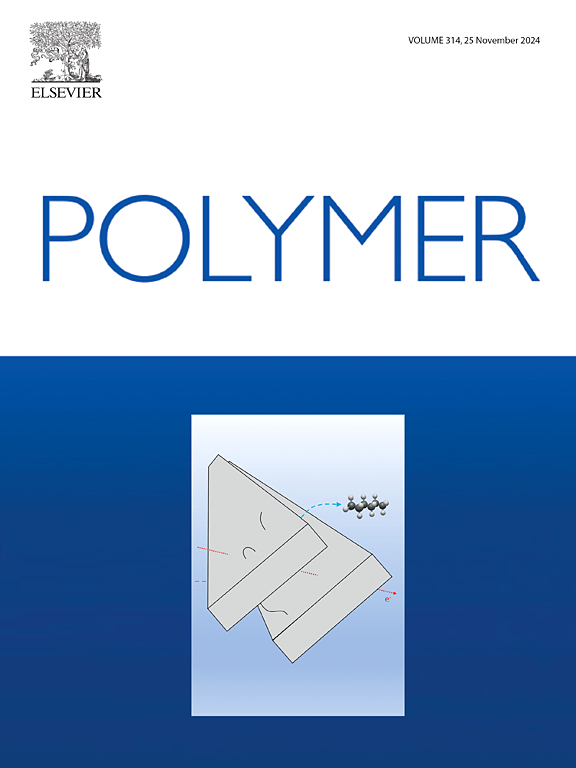半芳香族聚酰亚胺长时间紫外光致延迟发光的光物理分析及其与透氧性的关系
IF 4.1
2区 化学
Q2 POLYMER SCIENCE
引用次数: 0
摘要
合成了六种类型的光致发光聚酰亚胺(PIs)和共聚酰亚胺(co-PIs),以明确对具有长时间紫外线照射诱导延迟发光(PIDL)的PIs的要求。PIDL是在连续照射下,通过磷光体的三重态激子的能量转移,基态氧(3O2)逐渐被激发为单线态氧(1O2)而产生的一种磷光(PH)形式。当使用具有醚键的4,4'-氧二苯二酐(ODPA)作为发光单元时,通过与非发光二酐共聚稀释荧光粉单元可以有效地表现出强PH和PIDL发射。然而,由ODPA衍生的pi由于其柔性结构导致热失活,仅发出弱PH而没有PIDL。因此,利用具有刚性噻吩核的发光二苯并噻吩四羧酸二酐(DBSA)合成了四种类型的pi。用聚乙烯醇作为氧(O2)屏障涂层后,两种类型的pi在室温空气中表现出PIDL。这是PIDL排放的pi的第一篇报道,表明阻止O2渗透可以使3O2充分还原,这是显示PIDL的必要条件。此外,这两种PI表现出不同的PIDL强度和诱导时间,这是显示PIDL所需的经过时间,取决于PI膜内O2的渗透率和1O2的寿命。这些结果表明,由发光和非发光二酐的适当组合得到的pi可以在保持高热阻和良好的加工性能的同时表现出明显的PIDL。本文章由计算机程序翻译,如有差异,请以英文原文为准。


Photophysical analysis of prolonged UV irradiation-induced delayed luminescence of semi-aromatic polyimides and its relation to oxygen permeability
Six types of photoluminescent polyimides (PIs) and co-polyimides (co-PIs) were synthesized to clarify the requirements for PIs that exhibit prolonged UV irradiation-induced delayed luminescence (PIDL). PIDL is a form of phosphorescence (PH) observed after ground-state oxygen (3O2) is gradually excited to singlet oxygen (1O2) via energy transfer from triplet excitons of the phosphor under continuous irradiation. When 4,4'-oxydiphthalic dianhydride (ODPA), which has an ether linkage, is used as a luminescent unit, dilution of the phosphor unit by copolymerization with non-luminescent dianhydrides is effective in exhibiting strong PH as well as PIDL emission. However, PIs derived from ODPA emit only a weak PH without PIDL, which is caused by thermal deactivation owing to their flexible structure. Thus, four types of PIs were synthesized using luminescent dibenzothiophene tetracarboxylic dianhydride (DBSA) having a rigid thiophene core. Two types of PIs exhibited PIDL at room temperature in air when coated with polyvinyl alcohol as an oxygen (O2) barrier. This is the first report of PIs with PIDL emission, indicating that preventing O2 permeation allows sufficient reduction of 3O2, which is necessary for exhibiting PIDL. In addition, these two PIs exhibited different PIDL intensities and induction time, which is the elapsed time required to exhibit the PIDL, depending on the O2 permeability and lifetime of 1O2 within the PI films. These results clarify that PIs derived from a suitable combination of luminescent and non-luminescent dianhydrides can exhibit obvious PIDL while maintaining high thermal resistance and good processability.
求助全文
通过发布文献求助,成功后即可免费获取论文全文。
去求助
来源期刊

Polymer
化学-高分子科学
CiteScore
7.90
自引率
8.70%
发文量
959
审稿时长
32 days
期刊介绍:
Polymer is an interdisciplinary journal dedicated to publishing innovative and significant advances in Polymer Physics, Chemistry and Technology. We welcome submissions on polymer hybrids, nanocomposites, characterisation and self-assembly. Polymer also publishes work on the technological application of polymers in energy and optoelectronics.
The main scope is covered but not limited to the following core areas:
Polymer Materials
Nanocomposites and hybrid nanomaterials
Polymer blends, films, fibres, networks and porous materials
Physical Characterization
Characterisation, modelling and simulation* of molecular and materials properties in bulk, solution, and thin films
Polymer Engineering
Advanced multiscale processing methods
Polymer Synthesis, Modification and Self-assembly
Including designer polymer architectures, mechanisms and kinetics, and supramolecular polymerization
Technological Applications
Polymers for energy generation and storage
Polymer membranes for separation technology
Polymers for opto- and microelectronics.
 求助内容:
求助内容: 应助结果提醒方式:
应助结果提醒方式:


